|
(a) The label of a dietary supplement that is offered for sale shall bear nutrition labeling in accordance with this regulation unless an exemption is provided for the product in paragraph (h) of this section.
(b) The declaration of nutrition information on the label and in labeling shall contain the following information, using the subheadings and the format specified in paragraph (e) of this section.
(1) Serving size. (i) The subheading "Serving Size" shall be placed under the heading "Supplement Facts" and aligned on the left side of the nutrition label. The serving size shall be determined in accordance with §§ 101.9(b) and 101.12(b), Table 2. Serving size for dietary supplements shall be expressed using a term that is appropriate for the form of the supplement, such as "tablets," "capsules," "packets," or "teaspoonfuls."
(ii) The subheading "Servings Per Container" shall be placed under the subheading "Serving Size" and aligned on the left side of the nutrition label, except that this information need not be provided when it is stated in the net quantity of contents declaration.
(2) Information on dietary ingredients that have a Reference Daily Intake (RDI) or a Daily Reference Value (DRV) as established in § 101.9(c) and their subcomponents (hereinafter referred to as "(b)(2)-dietary ingredients"). (i) The (b)(2)-dietary ingredients to be declared, that is, total calories, total fat, saturated fat, trans fat, cholesterol, sodium, total carbohydrate, dietary fiber, total sugars, added sugars, protein, vitamin D, calcium, iron, and potassium, shall be declared when they are present in a dietary supplement in quantitative amounts by weight that exceed the amount that can be declared as zero in nutrition labeling of foods in accordance with § 101.9(c). Calories from saturated fat, polyunsaturated fat, monounsaturated fat, soluble fiber, insoluble fiber, and sugar alcohol may be declared, but they shall be declared when a claim is made about them. Any (b)(2)-dietary ingredients that are not present, or that are present in amounts that can be declared as zero in § 101.9(c), shall not be declared (e.g., amounts corresponding to less than 2 percent of the RDI for vitamins and minerals). Protein shall not be declared on labels of products that, other than ingredients added solely for technological reasons, contain only individual amino acids.
(A) The names and the quantitative amounts by weight of each (b)(2)-dietary ingredient shall be presented under the heading "Amount Per Serving." When the quantitative amounts by weight are presented in a separate column, the heading may be centered over a column of quantitative amounts, described by paragraph (b)(2)(ii) of this section, if space permits. A heading consistent with the declaration of the serving size, such as "Each Tablet Contains," or "Amount Per 2 Tablets" may be used in place of the heading "Amount Per Serving." Other appropriate terms, such as capsule, packet, or teaspoonful, also may be used in place of the term "Serving."
(B) The names of dietary ingredients that are declared under paragraph (b)(2)(i) of this section shall be presented in a column aligned on the left side of the nutritional label in the order and manner of indentation specified in § 101.9(c), except that calcium and iron shall follow choline, and sodium and potassium shall follow chloride. This results in the following order for vitamins and minerals: Vitamin A, vitamin C, vitamin D, vitamin E, vitamin K, thiamin, riboflavin, niacin, vitamin B6, folate and folic acid, vitamin B12, biotin, pantothenic acid, choline, calcium, iron, phosphorus, iodine, magnesium, zinc, selenium, copper, manganese, chromium, molybdenum, chloride, sodium, potassium, and fluoride. The (b)(2)-dietary ingredients shall be listed according to the nomenclature specified in § 101.9 or in paragraph (b)(2)(i)(B)(2 ) of this section.
(1 ) When "Calories" are declared, they shall be listed first in the column of names, beneath a light bar separating the heading "Amount Per Serving" from the list of names. When "Calories from saturated fat" are declared, they shall be indented under "Calories."
(2 ) The following synonyms may be added in parentheses immediately following the name of these (b)(2)-dietary ingredients: Vitamin C (ascorbic acid), thiamin (vitamin B1), riboflavin (vitamin B2), and calories (energy). Energy content per serving may be expressed in kilojoule units, added in parentheses immediately following the statement of caloric content.
(3 ) Beta-carotene may be declared as the percent of vitamin A that is present as beta-carotene, except that the declaration is required when a claim is made about beta-carotene. When declared, the percent shall be declared to the nearest whole percent, immediately adjacent to or beneath the name vitamin A (e.g., "Vitamin A (90% as beta-carotene)"). The amount of beta-carotene in terms of micrograms (mcg) may be included in the parentheses following the percent statement (e.g., "Vitamin A (90% (810 mcg) as beta-carotene)").
(ii) The number of calories, if declared, and the quantitative amount by weight per serving of each dietary ingredient required to be listed under paragraph (b)(2)(i) of this section shall be presented either in a separate column aligned to the right of the column of names or immediately following the listing of names within the same column. The quantitative amounts by weight shall represent the weight of the dietary ingredient rather than the weight of the source of the dietary ingredient (e.g., the weight of calcium rather than that of calcium carbonate).
(A) The amounts shall be expressed in the increments specified in § 101.9(c)(1) through (7), which includes increments for sodium.
(B) The amounts of vitamins and minerals, excluding sodium, shall be the amount of the vitamin or mineral included in one serving of the product, using the units of measurement and the levels of significance given in § 101.9(c)(8)(iv), except that zeros following decimal points may be dropped, and additional levels of significance may be used when the number of decimal places indicated is not sufficient to express lower amounts (e.g., the RDI for zinc is given in whole milligrams (mg), but the quantitative amount may be declared in tenths of a mg). The amount of vitamin D may, but is not required to, be expressed in IUs, in addition to the mandatory declaration in mcg. Any declaration of the amount of vitamin D in IUs must appear in parentheses after the declaration of the amount of vitamin D in mcg.
(iii) The percent of the Daily Value of all dietary ingredients declared under paragraph (b)(2)(i) of this section shall be listed, except that the percent Daily Value for protein, when present, shall be calculated using the corrected amount of protein as specified in § 101.9(c)(7)(ii); no percent of the Daily Value shall be given for subcomponents for which DRVs or RDIs have not been established (e.g., total sugars). Additionally, the percentage of the RDI for protein shall be omitted when a food is purported to be for infants through 12 months of age.
(A) When information on the percent of Daily Values is listed, this information shall be presented in one column aligned under the heading of "% Daily Value" and to the right of the column of amounts. The headings "% Daily Value (DV)," "% DV," "Percent Daily Value," or "Percent DV" may be substituted for "% Daily Value." The heading "% Daily Value" shall be placed on the same line as the heading "Amount Per Serving." When the acronym "DV" is unexplained in the heading and a footnote is required under (b)(2)(iii)(D), (b)(2)(iii)(F), or (b)(3)(iv) of this section, the footnote shall explain the acronym (e.g. "Daily Value (DV) not established").
(B) The percent of Daily Value shall be calculated by dividing the quantitative amount by weight of each (b)(2)-dietary ingredient by the RDI as established in § 101.9(c)(8)(iv) or the DRV as established in § 101.9(c)(9) for the specified dietary ingredient and multiplying by 100, except that the percent of Daily Value for protein, when present, shall be calculated as specified in § 101.9(c)(7)(ii). The quantitative amount by weight of each dietary ingredient in this calculation shall be the unrounded amount, except that for total fat, saturated fat, cholesterol, sodium, potassium, total carbohydrate, and dietary fiber, the quantitative amount by weight declared on the label (i.e., rounded amount) may be used. The numerical value shall be followed by the symbol for percent (i.e., %).
(C) The percentages based on RDI's and on DRV's shall be expressed to the nearest whole percent, except that for dietary ingredients for which DRV's have been established, "Less than 1%" or "<1%" shall be used to declare the "% Daily Value" when the quantitative amount of the dietary ingredient by weight is great enough to require that the dietary ingredient be listed, but the amount is so small that the "% Daily Value" when rounded to the nearest percent is zero (e.g., a product that contains 1 gram of total carbohydrate would list the percent Daily Value as "Less than 1%" or "<1%").
(D) If the percent of Daily Value is declared for total fat, saturated fat, total carbohydrate, dietary fiber, or protein, or added sugars, a symbol shall follow the value listed for those nutrients that refers to the same symbol that is placed at the bottom of the nutrition label, below the bar required under paragraph (e)(6) of this section and inside the box, that is followed by the statement "Percent Daily Values are based on a 2,000 calorie diet." If the product is represented or purported to be for use by children 1 through 3 years of age, and if the percent of Daily Value is declared for total fat, total carbohydrate, dietary fiber, or protein, or added sugars, a symbol shall follow the value listed for those nutrients that refers to the same symbol that is placed at the bottom of the nutrition label, below the bar required under paragraph (e)(6) of this section and inside the box, that is followed by the statement "Percent Daily Values are based on a 1,000 calorie diet."
(E) The percent of Daily Value shall be based on RDI or DRV values for adults and children 4 or more years of age, unless the product is represented or purported to be specifically for infants through 12 months of age, children 1 through 3 years of age, pregnant women, or lactating women, in which case the column heading shall clearly state the intended group. If the product is for persons within more than one group, the percent of Daily Value for each group shall be presented in separate columns as shown in paragraph (e)(11)(ii) of this section.
(F) For declared subcomponents that have no DRVs or RDIs, a symbol (e.g., an asterisk) shall be placed in the "Percent Daily Value" column that shall refer to the same symbol that is placed at the bottom of the nutrition label, below the last heavy bar and inside the box, and followed by a statement "Daily Value not established."
(G) When calories or calories from saturated fat are declared, the space under the "% DV" column shall be left blank for these items. When there are no other (b)(2)-dietary ingredients listed for which a value must be declared in the "% DV" column, the column may be omitted as shown in paragraph (e)(11)(vii) of this section. When the "% DV" column is not required, but the dietary ingredients listed are subject to paragraph (b)(2)(iii)(F) of this section, the symbol required in that paragraph shall immediately follow the quantitative amount by weight for each dietary ingredient listed under "Amount Per Serving."
(3) Information on dietary ingredients for which RDI's and DRV's have not been established. (i) Dietary ingredients for which FDA has not established RDI's or DRV's and that are not subject to regulation under paragraph (b)(2) of this section (hereinafter referred to as "other dietary ingredients") shall be declared by their common or usual name when they are present in a dietary supplement, in a column that is under the column of names described in paragraph (b)(2)(i)(B) of this section or, as long as the constituents of an other dietary ingredient are not listed, in a linear display, under the heavy bar described in paragraph (e)(6) of this section, except that if no (b)(2)-dietary ingredients are declared, other dietary ingredients shall be declared directly beneath the heading "Amount Per Serving" described in paragraph (b)(2)(i)(A) of this section.
(ii) The quantitative amount by weight per serving of other dietary ingredients shall be presented in the same manner as the corresponding information required in paragraph (b)(2)(ii) of this section or, when a linear display is used, shall be presented immediately following the name of the other dietary ingredient. The quantitative amount by weight shall be the weight of the other dietary ingredient listed and not the weight of any component, or the source, of that dietary ingredient.
(A) These amounts shall be expressed using metric measures in appropriate units.
(B) For any dietary ingredient that is a liquid extract from which the solvent has not been removed, the quantity listed shall be the volume or weight of the total extract. Information on the condition of the starting material shall be indicated when it is fresh and may be indicated when it is dried. Information may be included on the concentration of the dietary ingredient and the solvent used, e.g., "fresh dandelion root extract, x (y:z) in 70% ethanol," where x is the number of milliliters (mL) or mg of the entire extract, y is the weight of the starting material and z is the volume (mL) of solvent. Where the solvent has been partially removed (not to dryness), the final concentration, when indicated, shall be stated (e.g., if the original extract was 1:5 and 50 percent of the solvent was removed, then the final concentration shall be stated as 1:2.5). Where the name of the solvent used is not included in the nutrition label, it is required to be listed in the ingredient statement in accordance with § 101.4(g).
(C) For a dietary ingredient that is an extract from which the solvent has been removed, the weight of the ingredient shall be the weight of the dried extract.
(iii) The constituents of a dietary ingredient described in paragraph (b)(3)(i) of this section may be listed indented under the dietary ingredient and followed by their quantitative amounts by weight per serving, except that dietary ingredients described in paragraph (b)(2) of this section shall be listed in accordance with that section. When the constituents of a dietary ingredient described in paragraph (b)(3)(i) of this section are listed, all other dietary ingredients shall be declared in a column; however, the constituents themselves may be declared in a column or in a linear display.
(iv) Other dietary ingredients shall bear a symbol (e.g., an asterisk) in the column under the heading of "% Daily Value" that refers to the same symbol placed at the bottom of the nutrition label and followed by the statement "Daily Value not established," except that when the heading "% Daily Value" is not used, the symbol shall follow the quantitative amount by weight for each dietary ingredient listed.
(c) A proprietary blend of dietary ingredients shall be included in the list of dietary ingredients described in paragraph (b)(3)(i) of this section and identified by the term "Proprietary Blend" or other appropriately descriptive term or fanciful name and may be highlighted by bold type. Except as specified in this paragraph, all other requirements for the listing of dietary ingredients in dietary supplements are applicable.
(1) Dietary ingredients contained in the proprietary blend that are listed under paragraph (b)(2) of this section shall be declared in accordance with paragraph (b)(2) of this section.
(2) Dietary ingredients contained in the proprietary blend that are listed under paragraph (b)(3) of this section (i.e., "other dietary ingredients") shall be declared in descending order of predominance by weight, in a column or linear fashion, and indented under the term "Proprietary Blend" or other appropriately descriptive term or fanciful name.
(3) The quantitative amount by weight specified for the proprietary blend shall be the total weight of all other dietary ingredients contained in the proprietary blend and shall be placed on the same line to the right of the term "Proprietary Blend" or other appropriately descriptive term or fanciful name underneath the column of amounts described in paragraph (b)(2)(ii) of this section. A symbol (e.g., asterisk), which refers to the same symbol placed at the bottom of the nutrition label that is followed by the statement "Daily Value not established," shall be placed under the heading "% Daily Value," if present, or immediately following the quantitative amount by weight for the proprietary blend.
(4) The sample label shown in paragraph (e)(11)(v) of this section illustrates one method of nutrition labeling a proprietary blend of dietary ingredients.
(d) The source ingredient that supplies a dietary ingredient may be identified within the nutrition label in parentheses immediately following or indented beneath the name of a dietary ingredient and preceded by the words "as" or "from", e.g., "Calcium (as calcium carbonate)," except that manner of presentation is unnecessary when the name of the dietary ingredient (e.g., Oriental ginseng) or its synonym (e.g., ascorbic acid) is itself the source ingredient. When a source ingredient is identified in parentheses within the nutrition label, or when the name of the dietary ingredient or its synonym is the source ingredient, it shall not be required to be listed again in the ingredient statement that appears outside of the nutrition label. When a source ingredient is not identified within the nutrition label, it shall be listed in an ingredient statement in accordance with § 101.4(g), which shall appear outside and immediately below the nutrition label or, if there is insufficient space below the nutrition label, immediately contiguous and to the right of the nutrition label.
(1) Source ingredients shall be identified in accordance with § 101.4 (i.e., shall be listed by common or usual name, and the listing of botanicals shall specify the part of the plant from which the ingredient is derived) regardless of whether they are listed in an ingredient statement or in the nutrition label.
(2) When source ingredients are listed within the nutrition label, and two or more are used to provide a single dietary ingredient, all of the sources shall be listed within the parentheses in descending order by weight.
(3) Representations that the source ingredient conforms to an official compendium may be included either in the nutrition label or in the ingredient list (e.g., "Calcium (as calcium carbonate USP)").
(e) Except as provided for small and intermediate sized packages under paragraph (h)(3)(i)(2) of this section, information other than the title, headings, and footnotes shall be in uniform type size no smaller than 8 point. Type size no smaller than 6 point may be used for column headings (e.g., "Amount Per Serving" and "% Daily Value") and for footnotes (e.g., "Percent Daily Values are based on a 2,000 calorie diet").
(1) The title, "Supplement Facts," shall be set in a type size larger than all other print size in the nutrition label and, unless impractical, shall be set full width of the nutrition label. The title and all headings shall be bolded to distinguish them from other information.
(2) The nutrition information shall be enclosed in a box by using hairlines.
(3) All information within the nutrition label shall utilize:
(i) A single easy-to-read type style,
(ii) All black or one color type, printed on a white or other neutral contrasting background whenever practical,
(iii) Upper- and lowercase letters, except that all uppercase lettering may be utilized for packages that have a total surface area available to bear labeling of less than 12 square inches,
(iv) At least one point leading (i.e., space between lines of text), and
(v) Letters that do not touch.
(4) Except as provided for small and intermediate-sized packages under paragraph (i)(2) of this section, information other than the title, headings, and footnotes shall be in uniform type size no smaller than 8 point. Type size no smaller than 6 point may be used for column headings (e.g., "Amount Per Serving" and "% Daily Value") and for footnotes (e.g., "Percent Daily Values are based on a 2,000 calorie diet").
(5) A hairline rule that is centered between the lines of text shall separate each dietary ingredient required in paragraph (b)(2) and (b)(3) of this section from the dietary ingredient above and beneath it, as shown in paragraph (e)(10) of this section.
(6) A heavy bar shall be placed:
(i) Beneath the subheading "Servings Per Container" except that if "Servings Per Container" is not required and, as a result, not declared, the bar shall be placed beneath the subheading "Serving Size,"
(ii) Beneath the last dietary ingredient to be listed under paragraph (b)(2)(i) of this section, if any, and
(iii) Beneath the last other dietary ingredient to be listed under paragraph (b)(3) of this section, if any.
(7) A light bar shall be placed beneath the headings "Amount Per Serving" and "% Daily Value."
(8) If the product contains two or more separately packaged dietary supplements that differ from each other (e.g., the product has a packet of supplements to be taken in the morning and a different packet to be taken in the afternoon), the quantitative amounts and percent of Daily Value may be presented as specified in this paragraph in individual nutrition labels or in one aggregate nutrition label as illustrated in paragraph (e)(11)(iii) of this section.
(9)(i) The quantitative amount by weight (or volume, if permitted) and the percent of Daily Value of each dietary ingredient may be presented on a "per unit" basis in addition to the "per serving" basis required by paragraphs (b)(2)(ii) and (b)(2)(iii) of this section for (b)(2)-dietary ingredients and (b)(3)(ii) and (b)(3)(iv) of this section for other dietary ingredients. If "per unit" information is provided, it must be presented in additional columns to the right of the "per serving" information and be clearly identified by appropriate headings.
(ii) Alternatively, if a recommendation is made in other parts of the label that a dietary supplement be consumed more than once per day, the total quantitative amount by weight (or volume, if permitted) and the percent of Daily Value of each dietary ingredient may be presented on a "per day" basis in addition to the "per serving" basis required by paragraphs (b)(2)(ii) and (b)(2)(iii) of this section for (b)(2)-dietary ingredients and (b)(3)(ii) and (b)(3)(iv) of this section for other dietary ingredients. If "per day" information is provided, it must be presented in additional columns to the right of the "per serving" information and be clearly identified by appropriate headings and/or be presented in a parenthetical statement as part of the "Serving Size" declaration. A sample illustration for "per day" information in a column format is provided in paragraph (e)(11)(viii) of this section. As illustrated, the additional "Per Day" column heading is followed parenthetically by the number of servings recommended per day in other parts of the label (e.g., "Per Day (3 Caplets)"). When the parenthetical statement format following the "Serving Size" declaration is used as an alternative to the column format, the statement must provide no more than simple instructions regarding how to calculate the "per day" amount for the number of servings per day recommended in other parts of the label (e.g., "Serving Size: 1 Caplet (Multiply amounts by 3 for total daily amount)"). When the parenthetical statement format following the "Serving Size" declaration is used in addition to the column format, the statement must provide no more than a simple declaration of the number of servings recommended in other parts of the label (e.g., "Serving Size: 1 Caplet (Total daily amount: 3 caplets per day)").
(10) In the interest of uniformity of presentation, FDA urges that the information be presented using the graphic specifications set forth in appendix B to part 101, as applicable.
(11) The following sample labels are presented for the purpose of illustration:
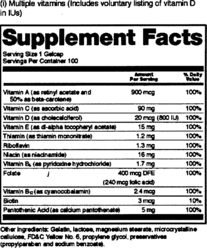
(ii) Multiple vitamins for children and adults (excludes Servings Per Container which is stated in the net quantity of contents declaration):
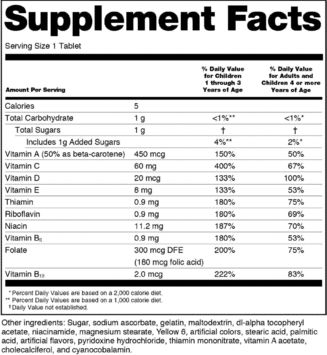
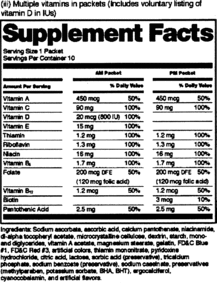
(iv) Dietary supplement containing dietary ingredients with and without RDIs and DRVs:

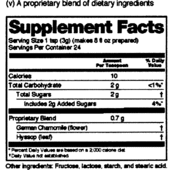

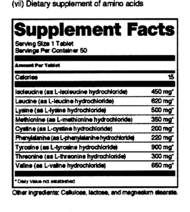

(12) If space is not adequate to list the required information as shown in the sample labels in paragraph (e)(11) of this section, the list may be split and continued to the right as long as the headings are repeated. The list to the right must be set off by a line that distinguishes it and sets it apart from the dietary ingredients and percent of Daily Value information given to the left. The following sample label illustrates this display:
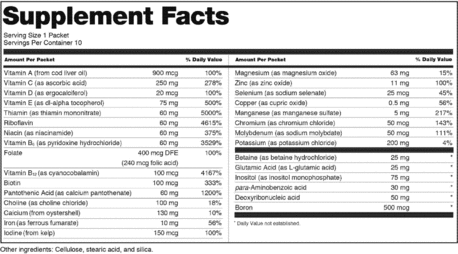
(f)(1) Compliance with this section will be determined in accordance with § 101.9(g)(1) through (g)(8), (g)(10), and (g)(11), except that the sample for analysis shall consist of a composite of 12 subsamples (consumer packages) or 10 percent of the number of packages in the same inspection lot, whichever is smaller, randomly selected to be representative of the lot. The criteria on class I and class II nutrients given in § 101.9(g)(3) and (g)(4) also are applicable to other dietary ingredients described in paragraph (b)(3)(i) of this section. Reasonable excesses over labeled amounts are acceptable within current good manufacturing practice.
(2) When it is not technologically feasible, or some other circumstance makes it impracticable, for firms to comply with the requirements of this section, FDA may permit alternative means of compliance or additional exemptions to deal with the situation in accordance with § 101.9(g)(9). Firms in need of such special allowances shall make their request in writing to the Office of Nutrition and Food Labeling (HFS-800), Food and Drug Administration, 5001 Campus Dr., College Park, MD 20740.
(g) Except as provided in paragraphs (i)(2) and (i)(5) of this section, the location of nutrition information on a label shall be in compliance with § 101.2.
(h) Dietary supplements are subject to the exemptions specified as follows in:
(1) Section 101.9(j)(1) for foods that are offered for sale by a person who makes direct sales to consumers (i.e., a retailer) who has annual gross sales or business done in sales to consumers that is not more than $500,000 or has annual gross sales made or business done in sales of food to consumers of not more than $50,000, and whose labels, labeling, and advertising do not provide nutrition information or make a nutrient content or health claim;
(2) Section 101.9(j)(18) for foods that are low-volume products (that is, they meet the requirements for units sold in § 101.9(j)(18)(i) or (j)(18)(ii)); that, except as provided in § 101.9(j)(18)(iv), are the subject of a claim for an exemption that provides the information required under § 101.9(j)(18)(iv), that is filed before the beginning of the time period for which the exemption is claimed, and that is filed by a person, whether it is the manufacturer, packer, or distributor, that qualifies to claim the exemption under the requirements for average full-time equivalent employees in § 101.9(j)(18)(i) or (j)(18)(ii), and whose labels, labeling, and advertising do not provide nutrition information or make a nutrient content or health claim;
(3) Section 101.9(j)(9) for foods shipped in bulk form that are not for distribution to consumers in such form and that are for use solely in the manufacture of other dietary supplements or that are to be processed, labeled, or repacked at a site other than where originally processed or packed.
(i)(1) Dietary supplements are subject to the special labeling provisions specified in § 101.9(j)(5)(i) for foods other than infant formula, represented or purported to be specifically for infants through 12 months of age and children 1 through 3 years of age.
(2) Section 101.9(j)(13) for foods in small or intermediate-sized packages, except that:
(i) All information within the nutrition label on small-sized packages, which have a total surface area available to labeling of less than 12 square inches, shall be in type size no smaller than 4.5 point;
(ii) All information within the nutrition label on intermediate-sized packages, which have from 12 to 40 square inches of surface area available to bear labeling, shall be in type size no smaller than 6 point, except that type size no smaller than 4.5 point may be used on packages that have less than 20 square inches available for labeling and more than 8 dietary ingredients to be listed and on packages that have 20 to 40 square inches available for labeling and more than 16 dietary ingredients to be listed.
(iii) When the nutrition information is presented on any panel under § 101.9(j)(13)(ii)(D), the ingredient list shall continue to be located immediately below the nutrition label, or, if there is insufficient space below the nutrition label, immediately contiguous and to the right of the nutrition label as specified in § 101.4(g).
(iv) When it is not possible for a small or intermediate-sized package that is enclosed in an outer package to comply with these type size requirements, the type size of the nutrition label on the primary (inner) container may be as small as needed to accommodate all of the required label information provided that the primary container is securely enclosed in outer packaging, the nutrition labeling on the outer packaging meets the applicable type size requirements, and such outer packaging is not intended to be separated from the primary container under conditions of retail sale.
(v) Where there is not sufficient space on a small or intermediate-sized package for a nutrition label that meets minimum type size requirements of 4.5 points if hairlines are used in accordance with paragraph (e)(5) of this section, the hairlines may be omitted and replaced by a row of dots connecting the columns containing the name of each dietary ingredient and the quantitative amounts (by weight and as a percent of Daily Value).
(3) Section 101.9(j)(15) for foods in multiunit food containers;
(4) Section 101.9(j)(16) for foods sold in bulk containers; and
(5) Section 101.9(j)(17) for foods in packages that have a total surface area available to bear labeling greater than 40 square inches but whose principal display panel and information panel do not provide sufficient space to accommodate all required label information, except that the ingredient list shall continue to be located immediately below the nutrition label, or, if there is insufficient space below the nutrition label, immediately contiguous and to the right of the nutrition label as specified in § 101.4(g).
(j) Dietary supplements shall be subject to the misbranding provisions of § 101.9(k).
[62 FR 49849, Sept. 23, 1997, as amended at 63 FR 30620, June 5, 1998; 66 FR 56035, Nov. 6, 2001; 71 FR 51726, Aug. 31, 2006; 71 FR 74791, Dec. 13, 2006; 81 FR 33994, May 27, 2016; 83 FR 65502, Dec. 21, 2018]
|